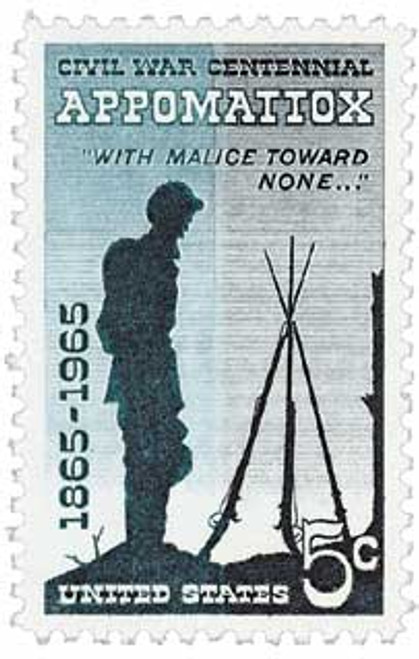
# 1178 - 1961 4c Civil War Centennial: Firing on Fort Sumter
4¢ Firing on Fort Sumter
Civil War Centennial Issue
City: Charleston, SC
Quantity: 101,125,000
Printed By: Bureau of Engraving and Printing
Printing Method: Rotary press
Perforations: 11 x 1.5
Color: Light green
Civil War Centennial Series
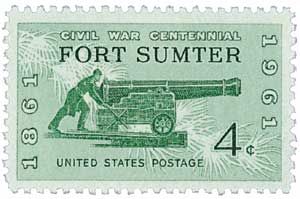
On April 12, 1961, the US Post Office issued the first stamp in a five-year series honoring major events from the Civil War.
Prior to this, the post office hadn’t issued stamps to commemorate any specific Civil War battles, though several stamps had been issued honoring generals from both sides of the war.
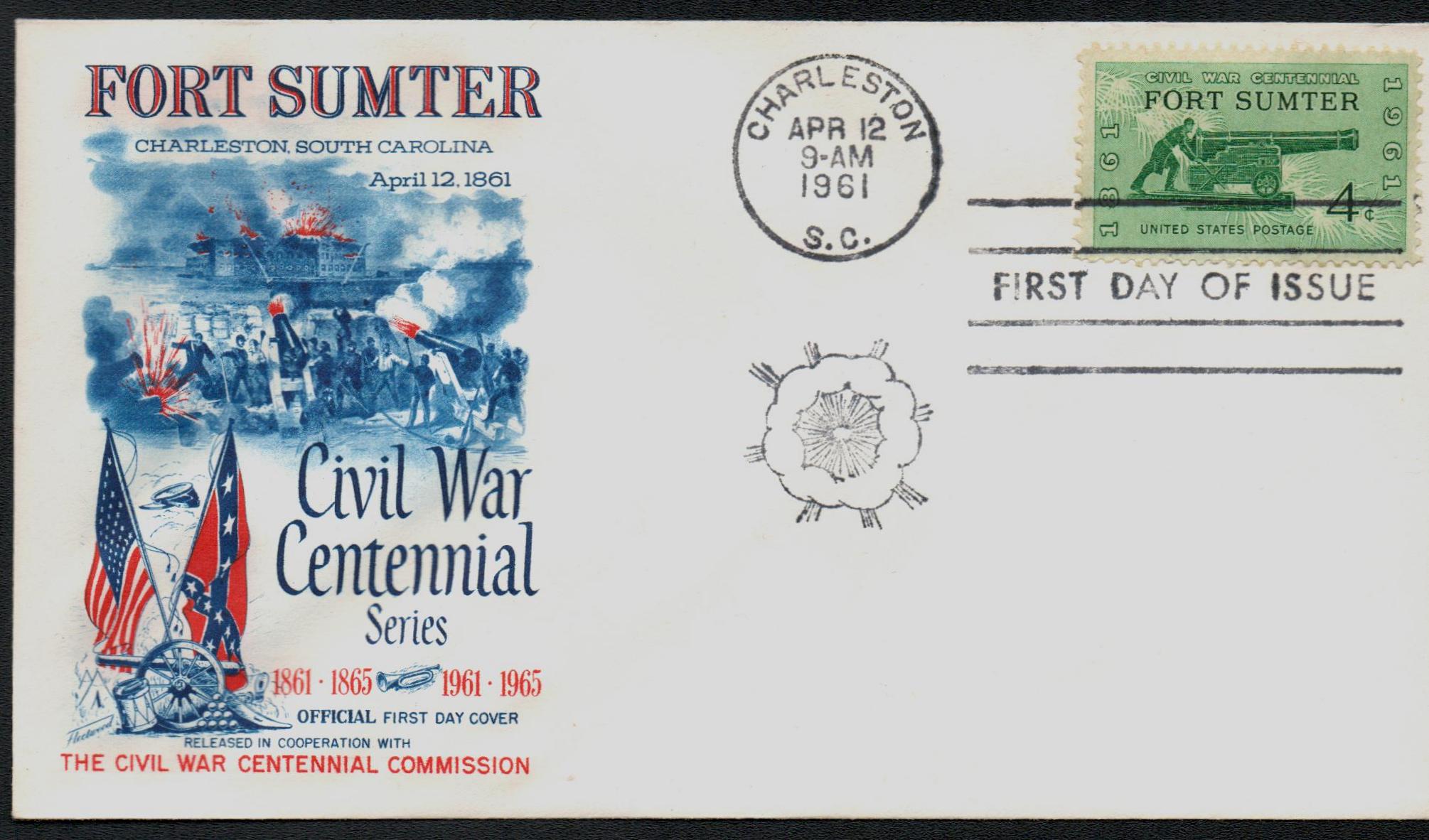
The first stamp in the series, honoring the Battle of Fort Sumter, was issued on April 12, 1961, the 100th anniversary of that battle. The stamp was issued at the Charleston, South Carolina post office. Based on a Harpers Weekly illustration from the time, it pictures a seacoast gun from the fort, manned by an officer in the typical uniform. Behind this are palmetto leaves. The palmetto is South Carolina’s state tree and the state’s nickname is the “Palmetto State.” The connection dates back to the Revolutionary War.
Fort Sumter was of little strategic importance to the US. It was incomplete, and all 60 of its guns faced the sea. However, it became a symbol of national unity. To President Lincoln, giving up the fort meant accepting secession. After demands for surrender, Confederate forces began a fierce bombardment of Fort Sumter on April 12, 1861. Two days later, Union forces evacuated the fort. The Confederates allowed Major Robert Anderson and his men to leave with their flag and weapons. Union forces regained control of Fort Sumter in February 1865. Click here for more about the Battle of Fort Sumter.
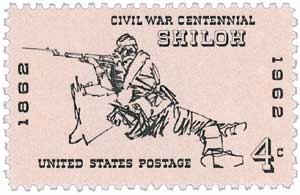
The second stamp in the series was issued on April 7, 1962, in Shiloh, Tennessee. The stamp shows a Civil War rifleman ducking behind a tree stump. The stamp was printed on peach blossom colored paper to honor the fact that an important part of the battle was fought in a peach orchard. The stamp’s drawing style mimics the quick battlefield sketches of combat artists such as Winslow Homer.
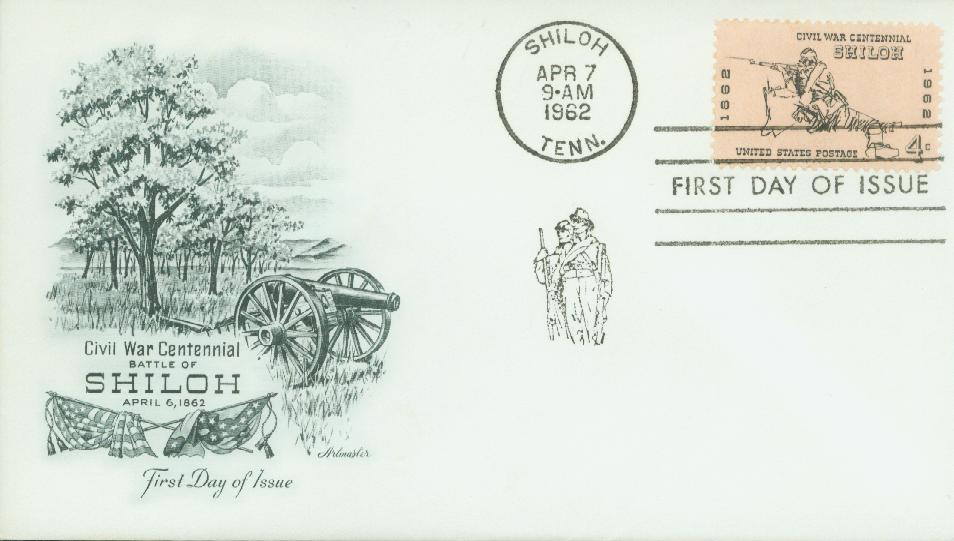
The Battle of Shiloh, named after a church on the battlefield, was fought on April 6 and 7, 1862. On the first day, Confederate General Albert Sidney Johnston’s surprise attack nearly smashed through Grant’s defenses. Johnston was killed in the fighting. The next day, Grant was reinforced with troops, and the general drove the Confederates to Corinth. About 13,000 Union troops and nearly 11,000 Confederate troops died at the battle. Click here for a more detailed history and more stamps honoring this battle.
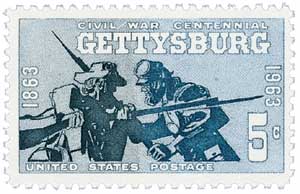
The third stamp in the series was issued on July 1, 1963, in Gettysburg, Pennsylvania. The stamp image is the result of the first nationwide contest sponsored by the Post Office Department inviting professional artists to design a US postage stamp. Pictured are a Confederate soldier on a gray background and Union soldier on a blue background.
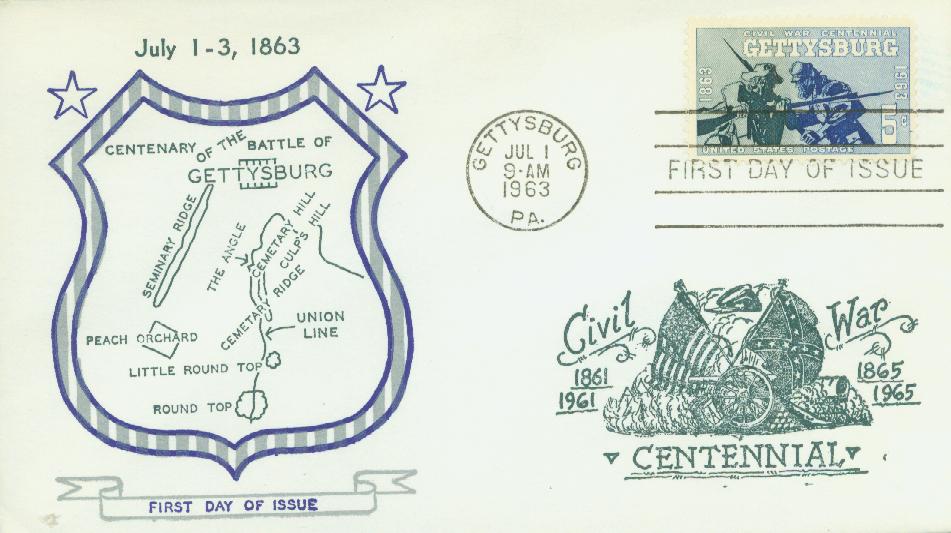
The Battle of Gettysburg was a major turning point in the American Civil War. General George C. Meade commanded a Union army of about 90,000 men against General Robert E. Lee’s Confederate army of 75,000. The two forces met by accident in the small town of Gettysburg, Pennsylvania. Both sides suffered terrible casualties, 22,800 men from the North and 22,600 from the South. However, the Confederates lost the battle. The Confederate army was battered and unable to recover from the loss. The South was never again able to launch a major offensive. Click here for more history and stamps honoring Gettysburg.

The fourth stamp in the series honoring the Battle of the Wilderness was issued on May 5, 1964, in Fredericksburg, Virginia. The stamp pictures three soldiers with a cannon. An artist who had been a runner-up in the previous year’s competition to design the Gettysburg stamp submitted the stamp’s design.

On May 5, 1864, as the Union army was beginning its march out of the wilderness, the Confederates attacked. Because of the thick vegetation in the forest, it was difficult to see or maneuver properly, making an effective battle impossible. Cavalry and artillery were useless in such an environment, so much of the fighting was nearly hand-to-hand. Before long, the flashes from muskets ignited the dry underbrush. Fire claimed the lives of many wounded still lying on the battlefield. Grant considered the battle a Union victory because he was able to accomplish his objective of getting his troops across the Rapidan River (practically in the face of Lee’s army) and re-forming as a unit on the other side. However, because of the heavy casualties on both sides, history remembers it as a tactical draw. Click here for more stamps and history behind this battle.
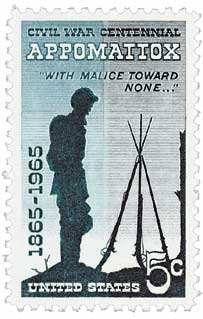
The final stamp in the series was issued on April 9, 1965, in Appomattox, Virginia. It pictures the silhouette of a soldier with a stack of rifles on a blue and gray background. It includes the phrase, “With malice toward none,” taken from Abraham Lincoln’s second inaugural address.
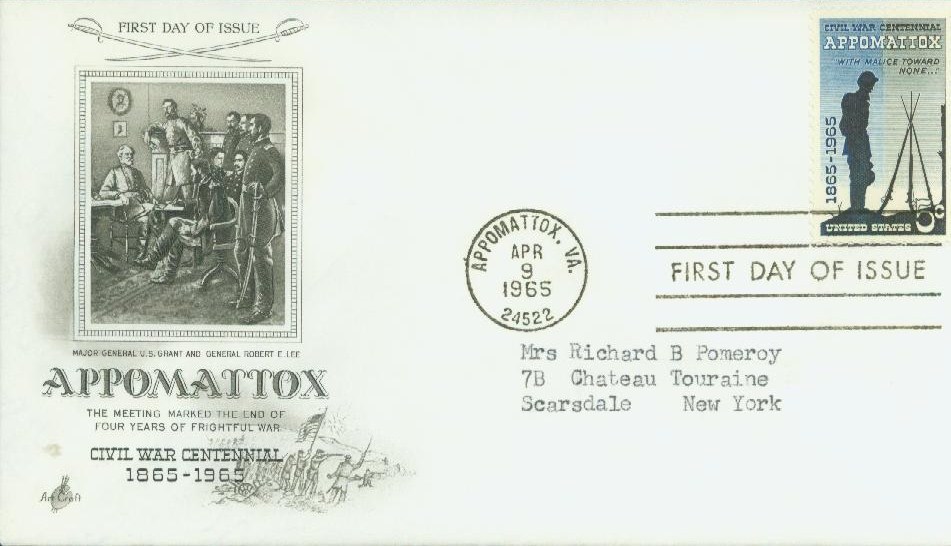
On April 9, 1865, after a week of almost daily conflicts with Grant’s Union army, Lee’s Confederates approached the small Virginia settlement of Appomattox. After a short battle with a much larger Union force at Appomattox, Lee sent word to Grant that he wished to surrender. Grant’s terms were generous. Soldiers were allowed to keep their horses for the next year’s plowing, and officers were allowed to keep their pistols. Grant also ordered that Confederate prisoners be fed with Union rations and that the Union soldiers refrain from celebrating the victory in the presence of the defeated Confederate army. At long last, America’s tragic Civil War had come to an end.
4¢ Firing on Fort Sumter
Civil War Centennial Issue
City: Charleston, SC
Quantity: 101,125,000
Printed By: Bureau of Engraving and Printing
Printing Method: Rotary press
Perforations: 11 x 1.5
Color: Light green
Civil War Centennial Series

On April 12, 1961, the US Post Office issued the first stamp in a five-year series honoring major events from the Civil War.
Prior to this, the post office hadn’t issued stamps to commemorate any specific Civil War battles, though several stamps had been issued honoring generals from both sides of the war.

The first stamp in the series, honoring the Battle of Fort Sumter, was issued on April 12, 1961, the 100th anniversary of that battle. The stamp was issued at the Charleston, South Carolina post office. Based on a Harpers Weekly illustration from the time, it pictures a seacoast gun from the fort, manned by an officer in the typical uniform. Behind this are palmetto leaves. The palmetto is South Carolina’s state tree and the state’s nickname is the “Palmetto State.” The connection dates back to the Revolutionary War.
Fort Sumter was of little strategic importance to the US. It was incomplete, and all 60 of its guns faced the sea. However, it became a symbol of national unity. To President Lincoln, giving up the fort meant accepting secession. After demands for surrender, Confederate forces began a fierce bombardment of Fort Sumter on April 12, 1861. Two days later, Union forces evacuated the fort. The Confederates allowed Major Robert Anderson and his men to leave with their flag and weapons. Union forces regained control of Fort Sumter in February 1865. Click here for more about the Battle of Fort Sumter.

The second stamp in the series was issued on April 7, 1962, in Shiloh, Tennessee. The stamp shows a Civil War rifleman ducking behind a tree stump. The stamp was printed on peach blossom colored paper to honor the fact that an important part of the battle was fought in a peach orchard. The stamp’s drawing style mimics the quick battlefield sketches of combat artists such as Winslow Homer.

The Battle of Shiloh, named after a church on the battlefield, was fought on April 6 and 7, 1862. On the first day, Confederate General Albert Sidney Johnston’s surprise attack nearly smashed through Grant’s defenses. Johnston was killed in the fighting. The next day, Grant was reinforced with troops, and the general drove the Confederates to Corinth. About 13,000 Union troops and nearly 11,000 Confederate troops died at the battle. Click here for a more detailed history and more stamps honoring this battle.

The third stamp in the series was issued on July 1, 1963, in Gettysburg, Pennsylvania. The stamp image is the result of the first nationwide contest sponsored by the Post Office Department inviting professional artists to design a US postage stamp. Pictured are a Confederate soldier on a gray background and Union soldier on a blue background.

The Battle of Gettysburg was a major turning point in the American Civil War. General George C. Meade commanded a Union army of about 90,000 men against General Robert E. Lee’s Confederate army of 75,000. The two forces met by accident in the small town of Gettysburg, Pennsylvania. Both sides suffered terrible casualties, 22,800 men from the North and 22,600 from the South. However, the Confederates lost the battle. The Confederate army was battered and unable to recover from the loss. The South was never again able to launch a major offensive. Click here for more history and stamps honoring Gettysburg.

The fourth stamp in the series honoring the Battle of the Wilderness was issued on May 5, 1964, in Fredericksburg, Virginia. The stamp pictures three soldiers with a cannon. An artist who had been a runner-up in the previous year’s competition to design the Gettysburg stamp submitted the stamp’s design.

On May 5, 1864, as the Union army was beginning its march out of the wilderness, the Confederates attacked. Because of the thick vegetation in the forest, it was difficult to see or maneuver properly, making an effective battle impossible. Cavalry and artillery were useless in such an environment, so much of the fighting was nearly hand-to-hand. Before long, the flashes from muskets ignited the dry underbrush. Fire claimed the lives of many wounded still lying on the battlefield. Grant considered the battle a Union victory because he was able to accomplish his objective of getting his troops across the Rapidan River (practically in the face of Lee’s army) and re-forming as a unit on the other side. However, because of the heavy casualties on both sides, history remembers it as a tactical draw. Click here for more stamps and history behind this battle.

The final stamp in the series was issued on April 9, 1965, in Appomattox, Virginia. It pictures the silhouette of a soldier with a stack of rifles on a blue and gray background. It includes the phrase, “With malice toward none,” taken from Abraham Lincoln’s second inaugural address.

On April 9, 1865, after a week of almost daily conflicts with Grant’s Union army, Lee’s Confederates approached the small Virginia settlement of Appomattox. After a short battle with a much larger Union force at Appomattox, Lee sent word to Grant that he wished to surrender. Grant’s terms were generous. Soldiers were allowed to keep their horses for the next year’s plowing, and officers were allowed to keep their pistols. Grant also ordered that Confederate prisoners be fed with Union rations and that the Union soldiers refrain from celebrating the victory in the presence of the defeated Confederate army. At long last, America’s tragic Civil War had come to an end.












